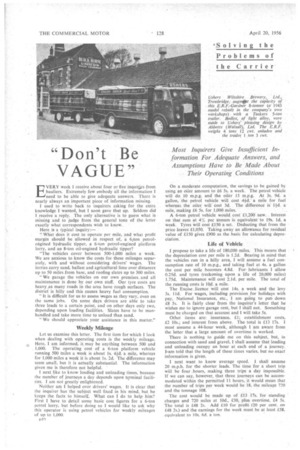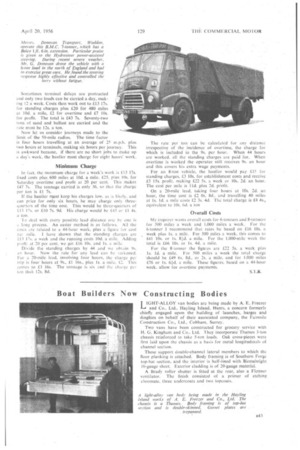"Don't Be VAGUE"
Page 74

Page 77

If you've noticed an error in this article please click here to report it so we can fix it.
Most Inquirers Give Insufficient Information For. Adequate Answers, and Assumptions Have to Be Made About Their Operating Conditions
EVERY week I receive about four or five inquides from hauliers. Extremely few embody all the information I need to be able to give adequate answers. There is nearly always an important piece of information missing.
I used to write back to inquirers asking for the extra knowledge I wanted, but I soon gave that up. Seldom did I receive a reply. The only alternative is to guess what is missing and to judge from the general tone of the letter exactly what correspondents wish to know.
Here is a typical inquiry:—
"What does it cost to operate per mile, and what profit margin should be allowed in respect of, a 6;ton petrolengined hydraulic tipper, a 6-ton petrol-engined platform lorry, and an 8-ton oil-engined hydraulic tipper?
"The vehicles cover between 500-1,000 miles a week. We are anxious to know the costs for these mileages separately, with and without considering drivers' wages. The lorries carry sand, ballast and agricultural lime over distances up to 50 miles from base, and roofing slates up to 300 miles.
"We garage the vehicles on our own premises. and all maintenance is done by our own staff. Our tyre costs are heavy as many roads in the area have rough surfaces. The district is hillyand this causes heavy fuel consumption.
"It is difficult for us to assess wages as they vary, even on the same jobs. On some days drivers are able to take three loads to a certain point, and on other days only two, depending upon loading facilities. ' Slates have to he manhandled and take more time to unload than sand.
"We should appreciate your assistance in this matter."
Weekly Mileage
Let us examine this letter. The first item for which I look when dealing with operating costs is the weekly mileage. Here, I am informed, it, may be anything between 500 and 1,000. The operating cost of a 6-ton platform vehicle running 500 miles a week is about Is. 40. a mile, whereas for 1,000 miles a week it is about Is. 2d. The difference may seem small, hut it is actually substantial. The information given me is therefore not helpful.
I next like to know loading and unloading times; because the number of journeys a day depends upon terminal facilities. I am not greatly enlightened.
Neither am I helped over drivers' wages. It is clear that the inquirer has the subject well fixed in his mind, hut he keeps the facts to himself. What can I do to help him? First I have to detail some basic cost figures for a 6-ton petrol lorry, but before doing so I would like to ask why this operator is using petrol vehicles for weekly mileages of up to 1,000.
R40
On a moderate computation, the savings to be gained by using an oiler amount to £65s. a week. The petrol vehicle will do 10 m.p.g. and the oiler 15 m.p.g. At 3s. 9d. a gallon, the petrol vehicle will cost .44d.a mile for fuel whereas the' oiler will cost 3d. The difference islid. a mile, making £6 -5s. for 1,000 miles.
A 6-ton petrol vehicle would cost £1,200 new.. Interest on that sum at 4% per annum is equivalent to 19s. Id. a week. Tyres will cost £150 a set. Deducting that from the price leaves £1,050. Taking away an allowance for residual value of £150 gives £900 as the basis for calculating depreciation.
Life of Vehicle i propose to take a life of 180,000 miles: This means that the depreciation cost per mile is I.2d. Bearing in mind that. the vehicles run in a hilly area, I will assume a fuel consumption rate of 10 m.p.g., and taking fuel at 4s. a gallon the cost per mile becomes 4.8d. Forlubricants I allow 0.25d. and tyres (reckoning upon a life of 20,000 miles) 1.75d. Maintenance will cost 2.1d. per mile. The total of the running costs is 10d. a mile.
The Excise, licence will cost 14s. a week and the levy 3s, 11d. For wages, including provision for holidays with pay, National Insurance, etc., I am going to put' down £8 5s. it is fairly clear from the inquirer's letter that he wishes me to ignore garage rent, but I shall not. Something must be charged on that account and I will take 5s.
Other items are: insurance, £1; establishment costs, £2 10s.; and interest from above. The total is £13 17s. I must assume a 44-hour week, although I am aware from the letter that a large amount of overtime is worked.
There is nothing to guide me on this subject, but, in connection with sand and gravel, I shall assume that loading and unloading occupy an hour at each end of a journey, 1.-nrn told that the length of these times varies, but no exact information is given.
I next want to know average speed. I shall assume 20 m.p.h. for the shorter leads. The time for a short trip will be four .hours, making three trips a day -impossible. If we can say, however, that three journeys can be accommodated within the permitted 11 honrs, it Would mean that the number of trips per week would be 18. the mileage 720 and the tonnage 108.
The cost would be made up of £13 17s. for standing charges and 720 miles at 10d., £30, plus overtime, £4 5s. The total is £48 2s. Add £10 for profit (20 per cent. on £48 25.). and the earnings for the week must be at least £58, equivalent to 10s. 6d. a ton.
Sometimes terminal delays are protracted and only two loads can be carried a day, making 12 a week. Costs then work out to £13 17s. for standing charges plus £20 for 480 miles at 10d. a mile, £2 for overtime and £7 10s. for profit. The total is £43 7s. Seventy-two tons of sand and ballast are carried and the rate must be 12s. a ton.
Now let us consider journeys made to the limit of the 50-mile radius. The time factor is four hours travelling at an average of 25 m.p.h. plus two hours at terminals, making six hours per journey. This is awkward because, if there arc no short jobs to make up a day's work. the haulier must charge for eight hours. work.
Minhnum Charge In fact, the .mimmum charge for a week's work is £13 17s. fixed costs plus 600 miles at 10d. a mile, £25, plus Ws. for Saturday overtime and profit at 20 per cent. This makes .C47 7s. The tonnage carried isonly 36, so that the charge per ton is £1 7s.
If the haulier nwst keep his charges low, as is likely, and can price for only six hours, he may charge only threequarters of the time cost. This would be three-quarters of £13 17s. or £10 7s. 9d. His charge would be £43 or LI 4s. a (On.
In deal with every possible •lead distance one by one is u long process. An easier method is as follows. All the costs are related to a 44-hour week, plus a figure for cost
per mile. I have shown that the standing charges are £13 17s. a week and the running costs 10d. a mile. Adding prolit at 20 per cent, we get £16 10s. and Is. a mile.
Divide the standing charges by 44 and we obtain 9s. .an hour. Now the rate for any lead can be reckoned. For a 20-mile lead, involving four hours, the charge per trip is four hours at 9s., El 16s., phis Is. a Mlle. £2. This comes to 13 16s. The tonnage is six and the charge per ton tlia's 12s. 8d.
The rate per ton can be calculated for any distance irrespective of the incidence of overtime, the charge for which is included in the 9s. per hour. When 44 hours• are worked, all the standing charges are paid for. When overtime is worked the operator still receives 9s. an hour and this covers his extra wage payments.
For an 8-ton vehicle; the haulier would pay £15 for standing charges, £3 10s. for establishment costs and receive 15s. profit, making £22 5s. a week or 10s. 2(1. an hour. The cost per mile is lid. plus 7d.
On a 20-mile lead, taking four hours at I0s. 2d. an hour, the time cost is £2 Os. 8d.. and travelling 40 miles at Is. id. a mile costs £2 3s. 4d. The total charge is £4 4s., equivalent to 10s. 6d. a ton
Overall Casts
My inquirer wants overall costs for 6-tonners and 8-tonners for 500 miles a week and 1.000 miles a week.. For the 6-tonner 1 recommend that rates be based on £16 10s. a week plus ls. a mile. For 500 miles a week, this comes to £41 10s. or Is. 81d. a mile. For the 1,000-mile week the total is £66 105. or Is. 4d. a mile.
For the 8-tonner the figtres are £22 5s, a week plus Is. Id. a mile. For 500 miles a week the total charge 'should be £49 6s. 8d., or 2s. a mile, and for 1,000 miles £76 or is. 61d. a mile. These figures, based on a 44-hour week, allow for overtime payments.
&1.R.




















































































































